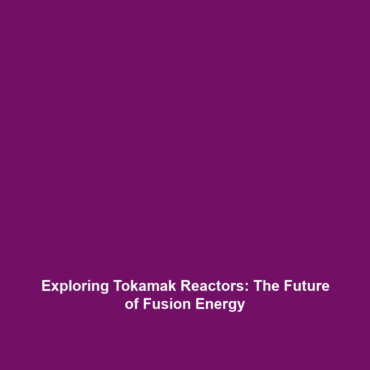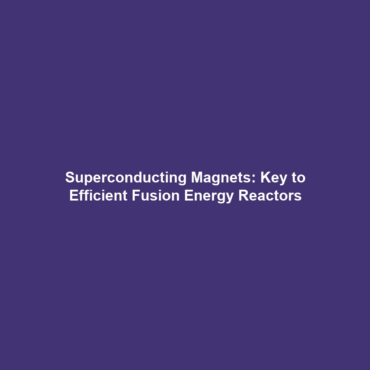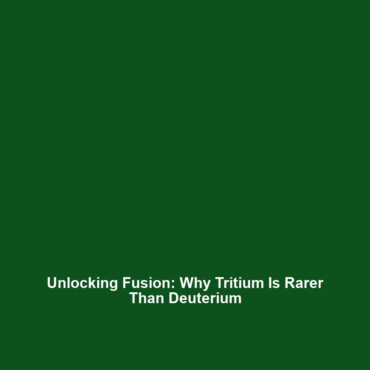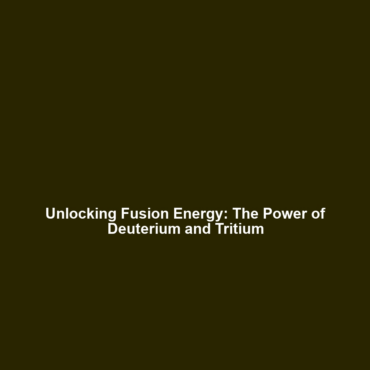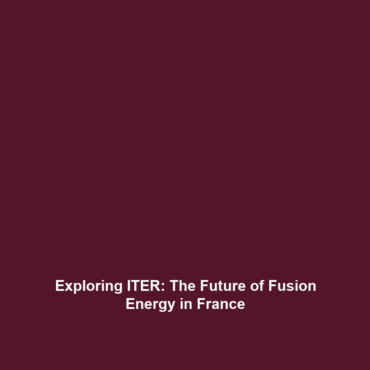Tritium: A Key Element in Fusion Energy
Tritium (T) is a radioactive isotope of hydrogen that plays a crucial role in the development of fusion energy. As the world seeks sustainable and clean energy alternatives, understanding Tritium’s properties and applications becomes increasingly important. This lightweight isotope is pivotal in fusion reactions, particularly in future nuclear fusion reactors, making it essential to explore its benefits and challenges in this context. In this article, we delve into the significance of Tritium within the broader framework of fusion energy research and its transformative potential in addressing global energy needs.
Key Concepts of Tritium in Fusion Energy
Tritium, with a nucleus containing one proton and two neutrons, is integral to the process of fusion. Its low atomic weight and ability to fuse at relatively lower temperatures compared to other isotopes make it an attractive candidate for future fusion technology. Key concepts related to Tritium in fusion energy include:
- Fusion Reaction: Tritium participates in fusion reactions primarily with deuterium, another hydrogen isotope. The reaction generates helium and releases significant energy, the foundation of fusion power.
- Sustainable Fuel Cycle: Tritium can be bred from lithium, using fusion reactions which can potentially create a self-sustaining fuel source for long-term energy solutions.
- Safety and Containment: As a radioactive substance, managing Tritium’s storage and containment presents unique challenges, critical for safe fusion reactor operation.
Applications and Real-World Uses of Tritium
The applications of Tritium extend beyond scientific research, significantly influencing developments in fusion energy. Some notable uses include:
- Fusion Reactors: Tritium is a primary fuel in experimental fusion reactors like ITER (International Thermonuclear Experimental Reactor), contributing to the pursuit of sustainable fusion energy.
- Radioluminescent Devices: Tritium is utilized in self-luminous devices, including watches and emergency exit signs, due to its radioactive properties that emit light.
- Medical Tracers: In medical imaging, Tritium-labeled compounds serve as tracers for biological studies, enhancing our understanding of cellular processes.
Current Challenges in Tritium Research
Despite its potential, there are notable challenges associated with Tritium in the context of fusion energy. These challenges include:
- Limited Availability: Tritium does not occur naturally in significant quantities and must be produced in nuclear reactors.
- Radioactive Management: Tritium’s radioactive nature necessitates careful management and containment to ensure safety.
- Breeding Efficiency: Achieving efficient breeding of Tritium from lithium in fusion reactors is presently a significant technical hurdle.
Future Research and Innovations Related to Tritium
Ongoing research is focused on enhancing Tritium production and utilization to advance fusion energy technologies. Key areas of innovation include:
- Improved Lithium Breeding Techniques: Developing more efficient processes for Tritium production via lithium is a focal point for future fusion reactor designs.
- Advanced Reactor Systems: Next-generation fusion reactors are being engineered to better harness Tritium and optimize fusion processes.
- Enhanced Safety Protocols: Research is ongoing to formulate advanced containment and safety measures for effective Tritium management.
Conclusion
In summary, Tritium stands at the forefront of research in fusion energy, embodying both opportunities and challenges. As the pursuit of sustainable energy solutions intensifies, Tritium’s potential in fusion reactors could revolutionize energy production worldwide. Continued exploration and innovation will be essential to overcome the existing hurdles associated with Tritium. For further insights into fusion energy, explore our articles on Nuclear Fusion Basics and Current Fusion Energy Projects.

